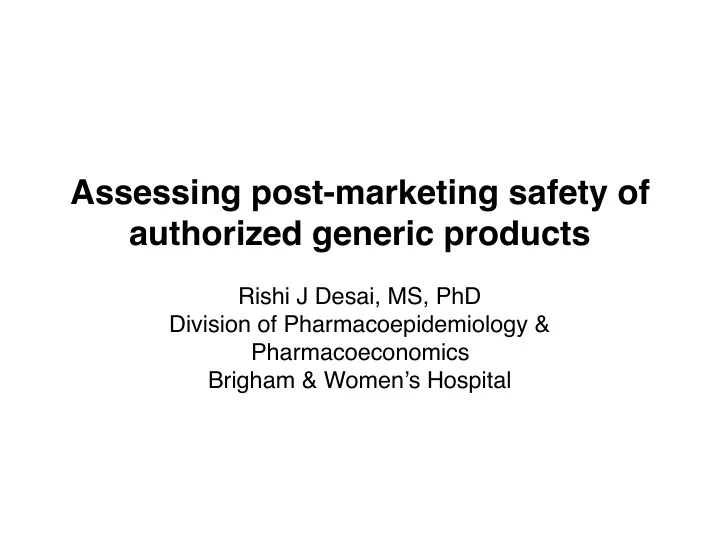

Assessing post-marketing safety of authorized generic products Rishi J Desai, MS, PhD Division of Pharmacoepidemiology & Pharmacoeconomics Brigham & Women’s Hospital
Background • Authorized generics (AGs) - AGs are a special case of generic drugs; they are brand-name products deriving US marketing approval based on the brand manufacturer’s new drug application (NDA) but marketed, sold, or distributed as generic medications. • Negative perception bias in comparative studies of generics - Generic drugs are often perceived to be less effective and safe as compared to the brand name product by patients as well as physicians (Shrank et al. Health Affairs, 2009; Shrank et al. Annals of Pharmacotherapy, 2011) - AGs provide a unique opportunity to unbiasedly understand the comparative effectiveness of generics versus brand products because they are essentially brand-name drugs perceived as generic drugs and therefore, a comparison of generics versus AGs is unlikely to be differentially affected by negative perceptions of generic drugs.
Objectives • We first described utilization patterns of the three versions within first 24 months of generic availability and compared switchback rates to brand-name versions between AGs and generics • We next compared clinical outcomes between AGs, generics, and brand-name versions of 8 pre-specified drug products
Data source and study drugs • Health insurance claims data from OptumInsight Clinformatics (2004-2013) • Study drugs and outcomes - 3 cardiovascular drugs- A composite CVD endpoint (stroke, MI, revascularizations) - 2 osteoporosis drugs- A composite fracture endpoint (humerus, wrist, hip, or pelvis fractures) - 1 diabetes drug- Initiation of insulin - 2 anti-depressants- Psychiatric hospitalizations
A. Substitution rates Substitution rates calculated as proportions of the total drug use accounted for by brand, AG and generics prescriptions every month Generic market entry date Month&1 Month&2 Month&24& 30&days 30&days 30&days
Figure 2- Substitution analysis
B. Switchback rates A. Substitution rates Follow-up for up to 365 Entry criterion days (Censor at treatment 1- Brand use Substitution rates calculated as discontinuation, switch when generics proportions of the total drug use between versions, or enter market accounted for by brand, AG and insurance ineligibility) generics prescriptions every month Generic market Generic market entry date Outcome date entry date Switch date Entry criterion 2- Outcome Month&1 Month&2 Month&24& Switch to a Switchback to 30&days 30&days 30&days generic version brand version (Group 1- AG Group 2- Generic)
Switchback analysis • A Cox proportional hazards (PH) regression model that adjusted for basic demographics (age, gender, and calendar year) gave hazard ratios (HR) and 95% confidence intervals for brand switchbacks comparing AG and generic groups • To derive summary effect estimates across the 8 included drug products, we conducted random effects meta-analysis to pool effect estimates for each comparison in the switchback analysis
Figure 3- Switchback analysis
B. Switchback rates A. Substitution rates Follow-up for up to 365 Entry criterion days (Censor at treatment 1- Brand use Substitution rates calculated as discontinuation, switch when generics proportions of the total drug use between versions, or enter market accounted for by brand, AG and insurance ineligibility) generics prescriptions every month Generic market Generic market entry date Outcome date entry date Switch date Entry criterion 2- Outcome Month&1 Month&2 Month&24& Switch to a Switchback to 30&days 30&days 30&days generic version brand version (Group 1- AG Group 2- Generic) D. Clinical outcomes (among brand, AG, C. Clinical outcomes (among AG or or generic initiators) generic switchers) Follow-up Follow-up Entry criterion 1- Entry criterion 1- (Censor at treatment (Censor at treatment No use of any version in a Brand use during a 6 month discontinuation, switch discontinuation, switch minimum of 6 month continuous insurance between versions, or between versions, or continuous insurance enrollment period insurance ineligibility) insurance ineligibility) enrollment period Outcome date Outcome date Index date Index date Entry criterion 2- Entry criterion 2- Clinical Clinical Newly filled Newly filled Outcome Outcome prescription for a prescription for any generic version version (Group 1- AG (Group 1- AG Group 2- Generic) Group 2- Generic Group 3- Brand)
Statistical analysis • For the comparative effectiveness analyses, propensity score (PS) based methods were used for rigorous confounding adjustment • PSs were calculated as the predicted probability of initiating the exposure group of interest (AGs in the AG versus generic and AG versus brand comparisons, Generics in the generic versus brand comparison) conditional upon patient covariate constellations • After calculating the PS, 1:1 matching procedure within a caliper of 0.025 of the PS was implemented for each comparison • In the matched cohorts, Cox PH models were used to derive the adjusted effect estimates in each comparison • To derive summary effect estimates across the 8 included drug products, we conducted random effects meta-analysis to pool effect estimates for each comparison in the switchback analysis
Figure 4- Clinical outcomes comparison- authorized generics versus generics A. Initiators comparison B. Switchers comparison
Figure 5- Clinical outcomes comparisons for brand-name products A. AG versus Brand-name initiators B. Generics versus Brand-name initiators
Summary • AG use was associated with significantly lower brand-switchbacks compared with generics, which may be attributable to similar pill characteristics such as color, shape, and size between AGs and brands • No significant differences were noted in clinical outcomes across the three versions • This study adds to mounting evidence that generics are associated with clinical benefit comparable to brand-name products
Study Team • Rishi Desai • Sarah Dutcher • Joshua J. Gagne • Said Raofi • Ameet Sarpatwari • Michael Fischer • Sara Dejene • Aaron Kesselheim • Nazleen Khan • Joyce Lii • James Rogers • Justin Bohn • John Connolly
Recommend
More recommend